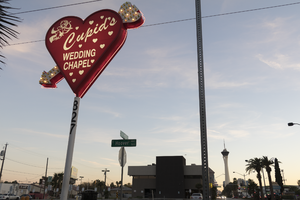Search the Special Collections and Archives Portal
Search Results
LGBTQ Las Vegas Records
Identifier
Abstract
The
Archival Collection

Transcript of interview with Florence McClure by Joanne Goodwin, January 24, 1996 & February 6, 1996
Date
Archival Collection
Description
Florence McClure came to Las Vegas later in her life, but the state felt her presence and the community her contributions as if she were a native daughter. Introduced to the League of Women Voters in 1967, McClure met her political mentor Jean Ford and learned how to practice the core elements of democracy. She put those tools to work in a number of ways, however her participation in the creation of the Rape Crises Center and her advocacy for locating the women’s prison near Las Vegas are two of her long-lasting efforts. Florence Alberta Schilling was born in southern Illinois where she enjoyed the security of a tight-knit family and the independence to test her abilities growing up. She graduated from high school and attended the MacMurray College for Women at Jacksonville. With the attack on Pearl Harbor in 1941, she began a series of jobs working for the war effort. She moved to Ypsilanti, Michigan with a girlfriend to work at the Willow Run Army Airbase and then moved to Miami, Florida where she worked for the Provost Marshall in the Security and Intelligence Division. She met her husband, James McClure, at the time and they married in 1945. During the next several years, they raised a family and moved around the country and to Japan with the military. McClure came to Las Vegas in 1966 as part of her work in the hotel industry which she engaged in after her husband’s retirement from the military. She had worked in California and Miami Beach, but it was Burton Cohen in Los Angeles who invited her to join him in a move to Las Vegas to build the new Frontier Hotel and Casino. Following the completion of the Frontier, she moved to the Desert Inn with Cohen in 1967 and worked as the executive office manager. After a few years, she decided to leave the industry and complete her college education. She graduated from UNLV in 1971with a BA in Sociology with an emphasis on criminology. She was 50 years old. McClure had been a member of the League of Women Voters for a few years at that point and had learned the political process from Jean Ford and workshops on lobbying. She had numerous skills that were waiting to be tapped when she attended an informational meeting on the incidence of rape in the Las Vegas valley. From that meeting, a small group of individuals, including McClure, began the organization Community Action Against Rape (later renamed the Rape Crisis Center) in 1973. It was the first agency in the area devoted to serving individuals who had been assaulted and changing the laws on rape. The organization’s first office was set up in McClure’s home. Over the next decade, she worked to change attitudes and reshape policy by constantly raising the issues of sexual assault with police officers, emergency room doctors, judges, and legislators. Her role as an advocate took her into hospital emergency rooms and courtrooms to assist victims. It also took her to the state legislator to lobby repeatedly for a change in laws. During this period, journalist Jan Seagrave gave McClure the nickname “Hurricane Florence” - a fitting moniker that captured the force with which McClure attacked the issue. As a result of her efforts and those of the people with whom she worked, we now 1) recognize rape as a crime of assault; 2) forbid the sexual history of a rape victim from being used against her in court; and 3) recognize marital rape. In addition to learning about Florence McClure’s activities, the reader of this interview will gain information on the role of civic organizations like the League of Women Voters in engaging the voluntary efforts of women in the post-war years.
Text

Interview with Donna Smith, November 4, 2006
Date
Archival Collection
Description
Text

Jean Sherman McColl interview, March 1, 1977: transcript
Date
Description
On March 1, 1977, collector Sam C. Melchiome Jr. interviewed Jean McColl (born May 24th, 1931 in California) at her home in Las Vegas, Nevada. In this interview, Jean McColl discusses growing up in Searchlight and then Las Vegas, Nevada. She discusses how her family came here as well as the many changes she has seen through the decades living in Las Vegas, Nevada.
Text

Ray D. Merrill interview, March 14, 1978: transcript
Date
Archival Collection
Description
On March 14, 1978, collector Rick Merrill interviewed his father Ray Merrill (born May 22nd, 1933 in Wynona, Oklahoma) about living in Southern Nevada. In this interview, Mr. Merrill speaks extensively about working while growing up in Las Vegas, Nevada. From eleven years old on, he worked as a paperboy, shoe shiner, and grocery store clerk, among other jobs. He also talks about being a student at Las Vegas High School and what he and others did for recreation. The discussion also includes the history of hospitals in Las Vegas as well as what doctors’ offices were like.
Text

Transcript of interview with Ruth Hazard by John Neal, March 8, 1975
Date
Archival Collection
Description
On March 8, 1975, John Neal interviews Ruth Hazard (birthdate unknown, 67 years old) in her home about her memory of how Southern Nevada has changed economically. Hazard goes in-depth about her knowledge of municipal politics and her husband’s friendships with a number of Nevadan politicians. Hazard also briefly talks about her fascination with the above-ground atomic tests, speakeasies during Prohibition, and local anxieties about Las Vegas “losing its identity.”
Text

Transcript of interview with Vaughan O. Holt by Lee LaVecchia, February 22, 1977
Date
Archival Collection
Description
On February 22, 1977, collector Lee LaVecchia interviewed musician, Vaughan O. Holt (born December 2nd, 1912 in Central, Utah) in his home in Las Vegas, Nevada. This interview covers the history of Southern Nevada. Mr. Holt offers an overview on marriage and family life in Las Vegas, local transportation, education, and occupations. Pollution, tourism, railroads, and the development of the Las Vegas Strip is also discussed. Mrs. Holt is also present during the interview.
Text

Luella Knuckles interview, February 28, 1980: transcript
Date
Archival Collection
Description
On February 28, 1980, Paul Gentle interviewed Luella Knuckles (b. 1910 in Impolla, Texas) about life as an African-American in Las Vegas, Nevada. Knuckles talks to Gentle about the conditions that African-Americans lived in and the discrimination they faced when first arriving to the city. Knuckles, in particular, spends a portion of the interview discussing the segregated layout of Las Vegas and the jobs and opportunities that were available for the black community in a segregated town. Moreover, she provides anecdotes about her deceased husband’s employment, their experience buying and repairing a property by themselves, and the changes in attitudes as the city desegregated. The conversation later focuses on the Church’s place in the African-American community, education and participation in church activities, and Knuckle’s personal love for books and Bible study.
Text

Transcript of interview with Christie Young by Dennis McBride, October 18, 1998
Date
Archival Collection
Description
I've known Christie Young for many years and was grateful she agreed to be interviewed for the Las Vegas Gay Archives Oral History Project. Not only is she frank in what she says, but her background as a researcher in sexual issues and as a straight woman involved in the gay community give her a unique perspective. Ancillary to her donation of this interview transcript to the University of Nevada, Las Vegas, Christie has generously donated her personal journals which detail more than a decade of her life including the years she worked with Las Vegas's gay community . Christie shares the project's concern that documentation of the gay community is ephemeral and vanishes rapidly; her determination that her contribution to that community be preserved greatly enriches our knowledge and will benefit future scholars.
Text

Photographs of Cupid's Wedding Chapel signs, Las Vegas (Nev.), March 13, 2017
Date
Archival Collection
Description
Site address: 827 S Las Vegas Blvd
Sign owner: Bellevue Holdings
Sign details: The original construction of this building was in 1950. This chapel is known for their weddings with Elvis Presley, James Brown and Johnny Cash impersonators.
Sign condition: 5- The sign is in very good condition with bright colored graphics with little/no fading
Sign form: Pylon
Sign-specific description: This sign has a white steel beam as its base. The shape of their sign is a red heart with a white arrow going through it. The red heart portion of the sign has a red steel sign box within this is a back lit red plastic sign with white font on it. Surrounding this sign is exterior skeletal neon that illuminates red at night time. The font on their sign states "Cupid's Wedding Chapel" with the word Cupid in a bubble cursive font and the "Wedding Chapel" portion in a white block font. Surrounding these letters are white hearts as well as an image of Cupid shooting a love arrow. The white arrow that shoots through the heart sign showcases flashing incandescent light bulbs.
Sign - type of display: Neon, incandescent and plastic backlit sign
Sign - media: Steel and plastic
Sign - non-neon treatments: Plastic backlit sign
Sign animation: Flasher for incandescent light bulbs
Sign environment: This location is a few blocks south of Fremont Street on Las Vegas Blvd. This chapel has other wedding chapels near it as well as the city courthouse and a few antique shops.
Sign - date of installation: This sign has been up since at least 2007.
Sign - thematic influences: The heart and arrow is symbolic to depict love and Cupid specifically, which helps showcase the theme and name of this location.
Sign - artistic significance: Chapels perpetuate Las Vegas as the Marriage capital of the world as well as maintaining their Neon Signs really pays tribute to Las Vegas' vintage culture.
Survey - research locations: Cupid's Chapel website http://www.cupidswedding.com/, Asessor's Page, Top 20 chapels in Vegas website https://www.gpsmycity.com/tours/top-20- vegas-wedding- chapels-1018.html , history channel website http://www.history.com/topics/valentines-day/history-of- valentines- day/pictures/valentines-day/cupids- wedding-chapel- in-las- vegas
Survey - research notes: The Cupid's Wedding Chapel sign was showcased on History. Com discussing Valentine's Day Weddings, and they gave the number that there were 2.2 million marriages in the U.S. in 2007 and 126,354 took place in Nevada. http://www.history.com/topics/valentines-day/history-of- valentines- day/pictures/valentines-day/cupids- wedding-chapel- in-las- vegas
Survey - other remarks: They were ranked 5 on the top 20 chapels to get married at here in Vegas. https://www.gpsmycity.com/tours/top-20- vegas-wedding- chapels-1018.html
Surveyor: Emily Fellmer
Survey - date completed: 2017-09-09
Sign keywords: Steel; Plastic; Backlit; Incandescent; Flashing; Neon; Pole sign
Mixed Content
